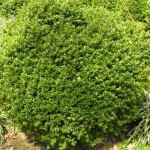Boxwood come in many shapes and sizes. There are many cultivar of boxwood though
mostly I see the American boxwood and the English boxwood. The American boxwood is simply the regeneration of the plant by seed where as an English boxwood is the regeneration of a cultivar by rooting a clipping from the selected plant. I have been given an odd boxwood dubbed the Weeping boxwood which has done very well and is an extremely fast grower, about a foot per year. One can generally tell the difference between an American, English and Weeping boxwoods by the shape and structure. The English is a dense slow growing shrub with smaller leaves than the American. The American grows faster and has an open sparse branch [Read more…]

